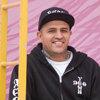
Q&A: Santiago Jaramillo, co-founder of D3 Arts
Santiago Jaramillo is a prominent Westwood artist and a member of the board at BuCu West. He's the muralist behind numerous works of street art on Morrison Road and elsewhere in Denver, the co-founder of D3 Arts and one of the visionaries who has propelled the Westwood Creative District from concept to reality.
Confluence Denver: What's your background? How long have you been in Westwood?
Santiago Jaramillo: I was born and raised here. I'm actually the third generation of my family that's lived here. My grandfather came from Mexico and moved here in the '50s. I've been here my whole life.
My art, I'm self-taught. I started painting when I was about 12 and I started doing it professionally 10 to 15 years ago. I do cultural stuff, Aztec, Native American things, tattoo-style art, abstract murals. I make Aztec drums, too. We take a tree trunk and hollow it out.
CD: What was your original vision for D3 Arts? How has it evolved?
SJ: The old director of BuCu West, Anne Lane, and Mandy Medrano actually came up with the idea for a creative arts district. They knew I lived here and that I was an artist. Mandy approached me and said, 'We want to do some stuff on Morrison Road, maybe some classes.' That's when the discussion of doing something creative in Westwood started, because nothing like that had ever been done before.
Then it just grew. Then Jose [Esparza] came on with BuCu and we started making a bigger push. I had my tattoo shop and gallery down there off of Lowell, and we would do a lot of events. Part of it for me was to prove we could actually get something going here in Westwood.
CD: What do you think of the potential for the Westwood Creative District?
SJ: We're really positive about it. It gives us validity and something to work for. It's like, 'Hey, we got this, we better do something with it.' So it's both a push and a huge achievement for me and Jose and Crystal and Julie at BuCu West. It's exciting to have this opportunity.
CD: What's the Morrison Road off the future look like in your vision?
SJ: Obviously, a lot of galleries. We're really fighting to get a skate park. For me, that's one of the biggest influences of why I started getting into art, through skateboarding. Skateboarding has so much art involved with it, it's like a part of skateboarding.
We also want to keep it unique to Westwood, because Westwood is Mexican-American, so we want to have it be at once modern and traditional as well as really cultural. And not just Mexican culture, but have a lot of different cultures represented in Westwood. But hopefully, it'll be unique, not just to Denver, but everywhere.